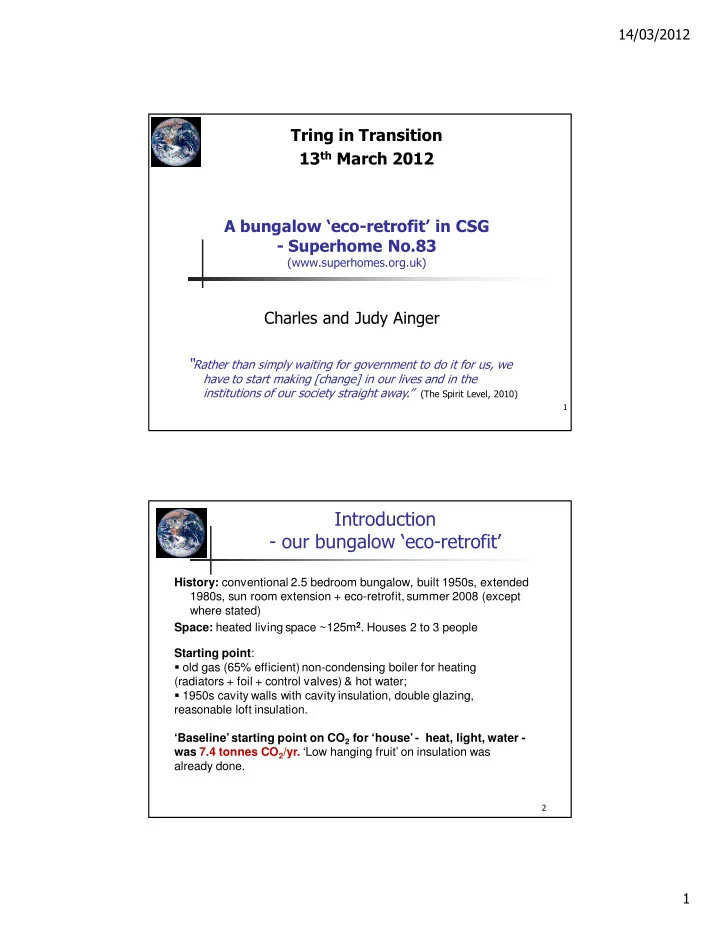

���������� ������������������� � �� !�����"# " �������������������������������� � ��������������� ����������������������� )��������� �*� ��+����� � ��������������������������������������������� �����������!���� ���������������������"#�����$���������������� �������� ����������������������#�������������������%�� �&���'������(����!������ � ,���� �#����� - ����.��������/�#�-��������0 History: conventional 2.5 bedroom bungalow, built 1950s, extended 1980s, sun room extension + eco-retrofit, summer 2008 (except where stated) Space: heated living space ~125m 2 . Houses 2 to 3 people Starting point : � old gas (65% efficient) non-condensing boiler for heating (radiators + foil + control valves) & hot water; � 1950s cavity walls with cavity insulation, double glazing, reasonable loft insulation. ‘Baseline’ starting point on CO 2 for ‘house’ - heat, light, water - was 7.4 tonnes CO 2 /yr. ‘Low hanging fruit’ on insulation was already done. � �
���������� ,���� �#�����1 ����������#���� ����� 2��������������������������� There are ‘low hanging fruit’ actions relevant to all properties: loft & cavity wall insulation, low energy light bulbs, double glazing, maybe floor insulation.. (we were on gas for heating & HW.) Beyond that the best combination of actions depend on: � your objectives: less CO 2 (major reduction), get off fossil fuels, less running cost, more comfort? and: � your property details, your starting point, and your £ to invest ( > £100k - major extension and roof renewal etc) � '�������1 .���������#�-������������3 �������������� ������ %� �������������� ���& � ���'������������������� ��������������� ������ ������������������� ������������������ !���� ������������������ ���������������� "��#�"�$� (���������������� ������������������� �������������������������&�� �������������������� ���������������������� ������������� �����������������&�� ������!%� �����(���������� ����������� ����������)*+,*����������� ������������������ "����$ ����������������� �#���������������� - ���������� ��'������'�����&������������. ������������'�����������/���� �������������� �������������� ��� ������� ���������� - ���0�1� �������� ������ ����������������������234�� 52� ���� ���3���������������� ��!�����"���#$�������������������������������������������������������������� 4������ �����6������&�� � �
���������� '�����45�1 ���#���#���������������������6 �����7!����������!���8)9+)���������� 20 panels on 35 deg South- facing roof 2 DC-AC inverters, on inside of gable wall in loft Annual solar electricity generation: 2,200kWh, replacing mains, 60% out of annual 4040 kWh. CO 2 saving = 1200kgCO 2 /yr (16%) : '�������������1 ��������������:�6� ����������;��������������#���� ���.���� 24 tubes, 2 pumps, two-coil HW tank, controls. (does ~ all hot water, May – September) � Saved ~1240 kWh/yr, out of 2800 for HW. This saves 230kg CO 2 /yr with the old gas boiler (OGB), but only 30kg/yr with the wood pellet boiler (WPB). � But the 2 pumps use extra 35 kWh mains electricity/yr = + 20kgCO 2 /yr. � So net kgCO 2 /yr saving = -210 (v. OGB); but only - 10 (v. WPB) – pumps cancel out pellets saving. < �
���������� (���=������.��.��>���������!����������� � Saved ~730 kWh/yr – 65% out of ~1130 kWh/yr for lighting � CO 2 saving = 390kg/yr (5%) ? 7��������,������������@ &�����������#���������1 �������������� A���� � Thermographic Survey B�#� 8�#� � �����#�������� ������!������� ����>�������������������������1 .��������� �����!�������������� ��.����!����.������������� ���@ 3 �
���������� �����,����������;�D5E��- D�#����#��� 5����������������E������#����� � Sloping roof insulation � Ducts, fan, heat exchanger � 80% exhaust air heat recovery claimed. � Insulation/MVHR saves 15% (4000kWh) of heating energy (& cost). This saves 780kg CO 2 /yr with the old gas boiler (OGB), but only 90kg/yr with the wood pellet boiler (WPB). � But the fan runs 24hrs/365days; extra 900kWh mains electricity/yr = + 475kgCO 2 /yr. � So net kgCO 2 /yr effect = -300 (v. OGB) - only 40% of saved gas energy; but + 385 (v. WPB) C +��-���������6�����#�������- �����������!� �����#�� ���������>� ���!������D5E� '���� 6 � Air Permeability Test � ��������������� .��� �������� ������ achieved 8.6 � ��������������������������� m 3 /(h.m 2 ), vs. target � ��..��� ������F#�� ������� ���� of 10. � Cost-effective for comfort; not for CO 2 ? � But helps allow boiler off longer in summer .. Air Permeability Test Kit �� :
���������� 7�� ������.����������� ���������.�����6� �������������� ������!�;������������� � 25 kW capacity, (���������������)�&���+���� ,����,/,�)� running at 10 kW; ��� (���������������)�* *� &'+�)&�� � 100% automatic – ��� A�. -��)� 3� ,�� ash cleaning once/yr .���� $��%� <� '��% � automatic feed from 3 ��&% E������� �� ������� ����&'()�& tonne hopper in shed; �� ���3-C truck delivery 2 x/yr � � : �� �: � usually runs October +����,����,-�,������,�)��./,�)� 0%1�����������2 to April – 7 months. Efficiency varies v. demand: av. 79% (v. claimed 86%) � Replaces fossil fuel gas (boiler @ 65% eff.) with 22,000 kWh (4.6 tonnes) of ‘renewable’ wood pellets. But; fans, pumps & ignition add 350 kWh/yr mains electricity, with CO 2 =190kg/yr � CO 2 saving = 4600kg/yr (62%) – without the other additional items; � these further reduce pellet use to 3.84 tonnes, 18,250 kWh/yr �� 7�� �������� ��������#��������.������ You need hopper space & lorry access �� <
Recommend
More recommend